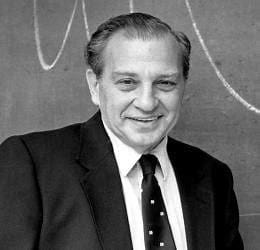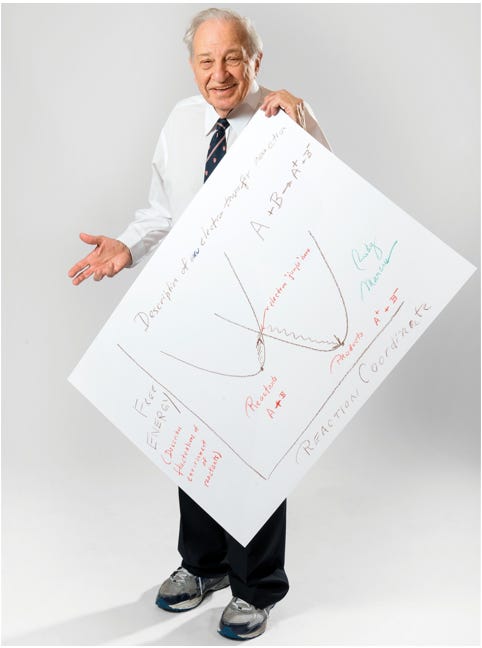If you find this work valuable, consider supporting it by becoming a paid subscriber. For just £3.50/month, you'll unlock full access to everything Electrochemical Insights has to offer.
Paid subscribers can reach out directly to me for guidance on their research, data analysis, and experimental design!
In the mid-20th century, when much of chemistry was still focused on cataloguing reactions and balancing equations, a quiet revolution was brewing in the realm of physical theory. At a time when experimental chemistry dominated, and the mysteries of electron transfer remained largely qualitative, one man built a bridge between molecular motion and measurable redox behaviour. His name was Rudolph A. Marcus.
Marcus did not come from one of the elite laboratories of Europe or the East Coast establishment. Instead, he carved his intellectual path through a blend of rigorous theoretical work and a relentless curiosity about the physical underpinnings of chemical change. Today, the Marcus theory of electron transfer is so deeply embedded in electrochemistry, biochemistry, and materials science that many scientists apply it without even realizing its revolutionary origins.
But Marcus's story is not just one of equations and Nobel Prizes. It's the story of how abstract thinking transformed how we understand the flow of electrons in redox systems, enabling the rise of modern sensor platforms, molecular electronics, and energy conversion technologies.
A Modest Beginning: Montreal and McGill
Born in Montreal in 1923 to a Jewish family with roots in Lithuania, Marcus was raised in a culturally rich environment. His father, Myer Marcus, worked as a manager in fruit stores and had a passion for cartooning, while his mother, Esther (née Cohen), was born in Manchester, England. His early years included time spent in Detroit before returning to Montreal, where he attended Baron Byng High School and developed a love for mathematics and science.
At McGill University, Marcus initially enrolled in engineering but gravitated toward physical chemistry. He was mentored by Carl A. Winkler, a student of Nobel laureate Cyril Hinshelwood, and took more mathematics courses than most of his chemistry peers — a decision that would later prove foundational to his theoretical innovations.
Marcus earned his B.Sc. in 1943 and his Ph.D. in 1946 from McGill. After graduation, he joined the National Research Council (NRC) in Ottawa, where he conducted experimental research under E.W.R. Steacie in gas-phase reaction kinetics.
Theory Born from Practice: The Road to RRKM
In 1949, Marcus moved to the University of North Carolina at Chapel Hill to work with theoretical chemist Oscar K. Rice. Within a few months, Marcus developed a generalization of Rice–Ramsperger–Kassel theory, later known as RRKM theory. This work bridged statistical mechanics with transition state theory and became a cornerstone of unimolecular reaction kinetics.
He published his findings in 1951–1952 while simultaneously beginning his independent academic career at the Polytechnic Institute of Brooklyn, where his theoretical and experimental programs flourished side by side.
Theoretical Groundwork: How Do Electrons Move?
In the 1950s, electron transfer reactions — like those between Fe²⁺ and Fe³⁺ — were considered mysterious. Their rates often defied expectations, and theories failed to predict them accurately. Marcus was intrigued. Drawing on his background in electrostatics and statistical mechanics, he reframed the problem: what if electron transfer is not just about redox potentials but also the reorganization of nuclei and solvent molecules?
In 1956, he introduced what is now known as Marcus theory, published in the Journal of Chemical Physics. It established that even outer-sphere electron transfers — those where no bonds are broken — require a reorganization of the solvent shell and internal coordinates of the donor and acceptor.
This schematic visualises how Marcus theory explains electron transfer between two molecular states:
Horizontal axis (Configuration coordinate): Represents the reorganisation of atomic positions and solvent structures as the system shifts from reactant to product.
Vertical axis (Energy): Shows the free energy of the system.
Black curve: Energy landscape of the initial (reactant) state.
Red curve: Final (product) state after electron transfer.
ΔG⁰ is the standard free energy change — the “downhill” energy gain from the reaction.
λ (lambda) is the reorganisation energy — the energy needed to reshape the system so the electron can hop.
At the point where the two curves cross, the system is in the correct geometry for the electron to transfer. This intersection defines the activation energy and controls how fast the electron jumps.
This image beautifully captures the central insight of Marcus theory: even reactions that release energy still require a preparatory energy investment — and understanding that balance allows us to predict rates and mechanisms with surprising accuracy. showing energy vs. reaction progress for electron transfer, with parabolic curves representing reactant and product states, and the activation barrier defined by reorganization energy (λ).
Marcus Equation:
k = A × exp[-(ΔG + λ)² / (4λkT)]
Where:
k is the rate constant
ΔG is the Gibbs free energy change
λ is the reorganization energy
k is the Boltzmann constant
T is temperature in Kelvin
Key Concepts:
Reorganization Energy (λ): Energy required to prepare both reactants and solvent for electron transfer.
Franck–Condon Principle: Electron transfer occurs faster than nuclear motion, so nuclei must already be in a favourable configuration.
Thermodynamic Parabola: The free energy surface for electron transfer is parabolic, leading to the famous prediction of the inverted region.
The Inverted Region: A Prediction Ahead of Its Time
One of the most surprising—and initially controversial—predictions of Marcus theory is the existence of an inverted (or anomalous) region in electron transfer reactions. Traditionally, chemists assumed that making a reaction more exergonic (i.e., increasing the driving force, −ΔG°) would always lead to faster reaction rates. But Marcus proposed something very different.
According to his theory, the rate of electron transfer increases with −ΔG° only up to a certain point. Specifically, the rate peaks when the driving force matches the reorganisation energy (λ)—the energy required to reorganise the nuclei and solvent environment during electron transfer. This is known as the activationless point (−ΔG° = λ).
Beyond that point—when −ΔG° exceeds λ—something unexpected happens: the reaction rate begins to decline, even though the reaction becomes more thermodynamically favourable. This is the inverted region (or anomalous region, as labelled in the diagram).
Why? The key lies in the overlap of potential energy surfaces. In the normal region (−ΔG° < λ), there's a reasonable energy barrier between the reactant and product states, and the reaction rate increases with more driving force. At the activationless point (−ΔG° = λ), the transition is barrierless and the rate reaches its maximum. But in the inverted region (−ΔG° > λ), the energy surfaces are so far out of sync that the system must reorganise more than necessary, creating a new barrier and slowing the reaction down.
For decades, this prediction remained purely theoretical. It wasn’t until the 1980s—thanks to the development of ultrafast laser spectroscopy—that the inverted region was finally confirmed. Using finely tuned donor–acceptor systems, researchers were able to experimentally observe the decline in electron transfer rate with increasing −ΔG°, just as Marcus had predicted decades earlier.
This was more than a validation of theory—it was a paradigm shift. The Marcus inverted region showed that reaction rates don’t always follow intuition. Instead, they depend on the delicate interplay between thermodynamics and nuclear reorganisation—a core insight that continues to shape our understanding of electron transfer in chemistry, biology, and materials science today.
From Scepticism to Stockholm
In the early years, reviewers dismissed Marcus’s first paper as “obviously written by a physicist who doesn’t know any chemistry.” But over time, Marcus theory became indispensable — especially in understanding photosynthesis, enzyme catalysis, and molecular electronics.
In 1992, Rudolph A. Marcus was awarded the Nobel Prize in Chemistry, cited “for his contributions to the theory of electron transfer reactions in chemical systems.”
Why Marcus Theory Matters Today
Marcus theory is not just a niche tool — it is foundational across multiple domains:
1. Electrochemistry and Biosensors
Redox probe kinetics, surface blocking effects, and electrode modifications are all interpreted through the lens of Marcus theory.
2. Biochemistry and Enzymatic Electron Transfer
Marcus’s framework helps explain the precise control of electron flow in cytochromes and respiration chains.
3. Photovoltaics and Artificial Photosynthesis
Charge injection in dye-sensitized solar cells and recombination kinetics are predicted using extensions of Marcus theory.
4. Molecular Electronics and Quantum Dots
Single-electron devices, molecular diodes, and nanoscale redox-active systems rely on Marcus-type models.
The Physicist’s Chemist
Marcus never viewed theory as separate from practice. His earliest work was deeply experimental, and even in theoretical pursuits, he grounded his thinking in physical insight. This perspective made his work unusually robust and adaptable — spanning unimolecular gas-phase reactions, electron transfer, vibrational dynamics, and reaction path analysis.
In later decades, Marcus explored vibronic coupling, semiclassical trajectories, and chaos theory in molecular dynamics. He brought a rare clarity and humility to his field, often crediting others like Henry Taube, Willard Libby, and Jean-Michel Savéant for extending or inspiring his ideas.
A Legacy Etched in Electron Motion
Rudolph A. Marcus helped transform chemistry from a descriptive to a predictive science. He showed that even the invisible motion of electrons through a molecular landscape could be quantified, modelled, and understood.
His theory is more than a tool — it’s a lens. It allows scientists to look at redox systems and see not just what happened, but why. In doing so, Marcus didn’t just advance electrochemistry — he reshaped it.
As we continue building molecular-scale sensors, quantum materials, and artificial photosynthetic platforms, we do so on the shoulders of Marcus — the theorist who gave electrons a roadmap and chemists a compass.
A Century of Impact — And Still Counting
Remarkably, Rudolph A. Marcus is still with us. As of 2025, he remains affiliated with the California Institute of Technology and Nanyang Technological University, Singapore. He celebrated his 100th birthday in July 2023 and continues to contribute intellectually to his field.
Marcus’s life is not only a testament to scientific rigor but also to the enduring value of curiosity. He has authored or co-authored over 250 papers, shaped countless careers, and changed how we think about one of nature’s most fundamental processes.
Few scientists live long enough to see their theories validated, taught, extended, and still considered vital more than half a century later. Fewer still remain active into their second century.
In every voltammogram, in every photosynthetic pathway, in every blinking quantum dot — a trace of Marcus’s vision endures.
Thank you for supporting Electrochemical Insights!








